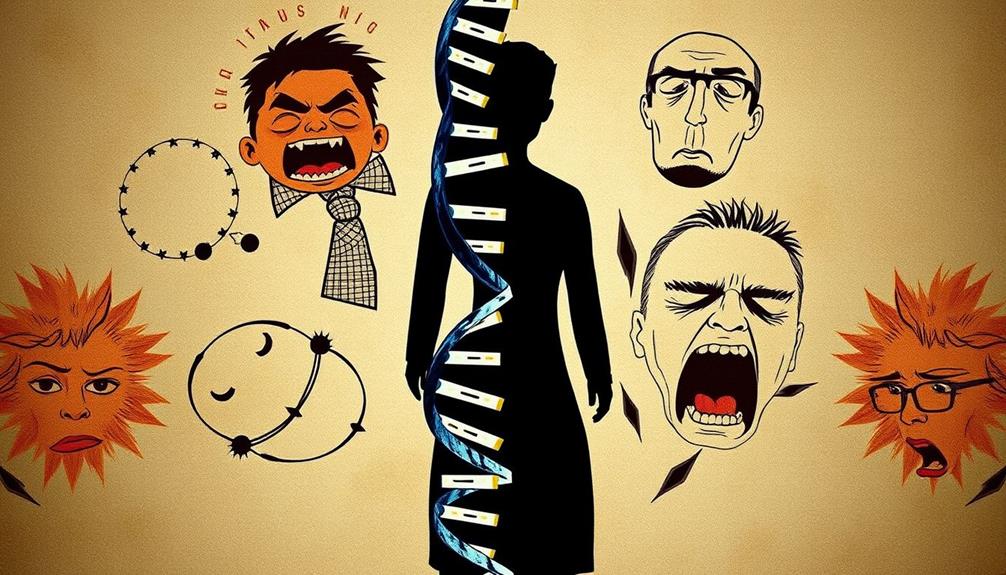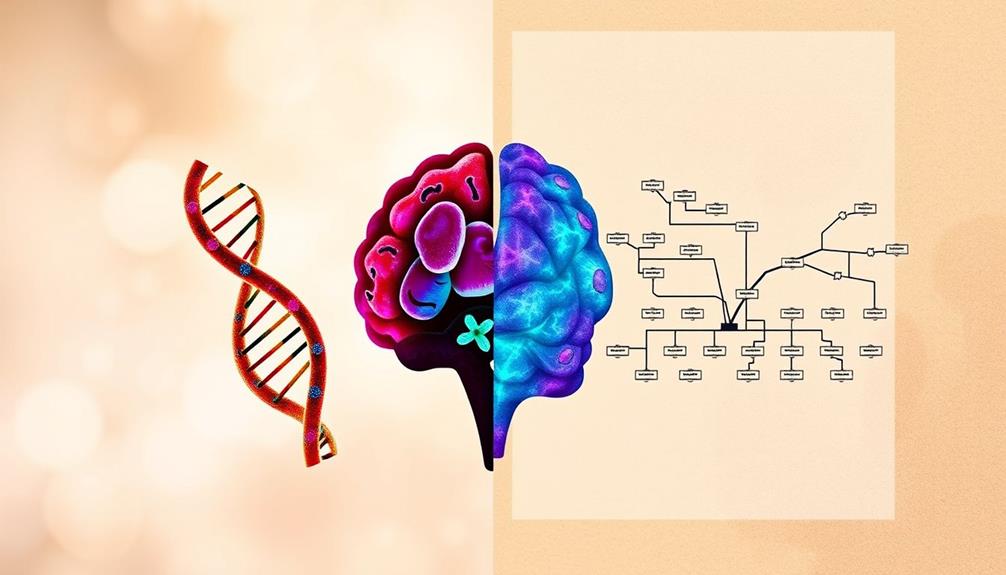Genetic factors considerably influence Borderline Personality Disorder (BPD), with around 46% of the risk linked to hereditary influences. If you have a family member with BPD, your risk of developing the disorder increases. Studies show that monozygotic twins have a much higher chance of developing BPD compared to dizygotic twins or siblings. However, it's vital to recognize the role of environmental factors too, such as childhood trauma, which can amplify genetic risks. Understanding these complexities can be pivotal for effective treatment. There's much more to uncover about this connection, and the details can really deepen your insight.
Key Takeaways
- BPD has a heritability estimate of approximately 46%, indicating a significant genetic component to the disorder.
- Monozygotic twins have a much higher risk of developing BPD, demonstrating strong genetic influence compared to dizygotic twins and full siblings.
- Specific genetic markers, such as DPYD and PKP4, have been linked to increased risk for developing BPD.
- Environmental factors, particularly childhood trauma, interact with genetic predispositions to exacerbate BPD symptoms.
- Personalized treatment strategies incorporating genetic insights can enhance intervention effectiveness and risk assessment for individuals and families.
Understanding Borderline Personality Disorder

Borderline Personality Disorder (BPD) affects about 1.6% of adults in the U.S., and understanding its complexities can be vital for both those diagnosed and their loved ones. BPD is marked by emotional instability, impulsivity, and intense interpersonal relationships, which can create considerable challenges in daily life.
The disorder often co-occurs with other mental health issues, such as depression and anxiety, complicating the treatment process. The onset typically occurs in late adolescence or early adulthood, and while symptoms can improve with age, they often require ongoing attention and care. Common symptoms include intense episodes of anger, depression, and anxiety lasting from a few hours to a few days, as well as chronic feelings of emptiness and difficulty in maintaining a stable self-image, indicating the need for thorough management strategies.
Research indicates that genetic factors play a major role in BPD, with heritability estimates around 46%. Family studies reveal that this personality disorder is more common among relatives of affected individuals, showing hazard ratios of 11.5 for identical twins and 4.7 for full siblings. This suggests that if someone in your family has BPD, you might be at a higher risk of developing it too.
However, it's important to remember that environmental influences also contribute considerably to BPD. Factors such as childhood trauma or unstable family dynamics can exacerbate symptoms.
Understanding both genetic predispositions and environmental factors is essential in addressing the mental health challenges associated with BPD and finding effective management strategies.
Genetic Influences on BPD

When you look at Borderline Personality Disorder (BPD), you'll find that genetics play a vital role, with heritability estimates around 46%. This means that if someone in your family has BPD, your risk of developing it increases considerably.
Research suggests that a combination of biological, psychological, and environmental factors contributes to the development of the disorder.
However, it's important to remember that your environment also influences how these genetic factors come into play, shaping your overall mental health.
Heritability Estimates of BPD
The heritability of Borderline Personality Disorder (BPD) highlights the significant role genetics play in its development. Research estimates this heritability at around 46%, which underscores the genetic influences on BPD.
Twin studies reveal that monozygotic (identical) twins carry a higher risk for BPD, with a hazard ratio of 11.5, compared to 7.4 for dizygotic (fraternal) twins. This strong genetic component is further supported by family studies showing that individuals with a first-degree relative diagnosed with BPD have a heightened likelihood of developing the disorder, with hazard ratios of 4.7 for full siblings.
Understanding the importance of selecting the right interventions is vital, as genetic predispositions may inform treatment approaches for mental health conditions, including cold medications overview.
Specific genes, like DPYD and PKP4, have been identified as potential contributors to BPD risk, indicating a genetic architecture that overlaps with other mental health conditions.
However, it's important to reflect that approximately 54% of BPD risk stems from unique environmental factors rather than shared familial environments. This interplay between genetic influences and environmental factors is essential for understanding the complexities of BPD.
Ultimately, recognizing the heritability of BPD can inform clinical diagnosis and treatment strategies, marking a significant step towards better mental health outcomes.
Gene-Environment Interactions
Understanding gene-environment interactions is essential for grasping how genetic predispositions influence the development of Borderline Personality Disorder (BPD). Genetic factors contribute considerably—about 40-60%—to the risk of developing BPD, indicating a hereditary component. However, these genetic influences don't act in isolation. They interact closely with environmental causes, particularly childhood trauma.
Individuals with a family history of BPD are at a heightened risk, as they may experience environmental stressors that exacerbate their genetic vulnerabilities. Research highlights that specific genes, like CACNA1C and ODZ4, can amplify this risk when paired with adverse experiences during formative years.
Here's a visual representation of these interactions:
| Genetic Factors | Environmental Causes | Impact on BPD |
|---|---|---|
| Hereditary traits | Childhood trauma | Increased risk of developing BPD |
| Family history | Stressful life events | Heightened vulnerability to BPD |
| Specific genes | Negative relationships | Greater symptom expression |
| Genetic predispositions | Environmental stressors | Combined risk factors for BPD |
Heritability Estimates and Studies

When exploring Borderline Personality Disorder (BPD), you'll find that heritability estimates suggest a significant genetic influence, ranging from 40% to 60%.
This aligns with the understanding of how common financial terms can impact decision-making, similar to how genetic factors can influence mental health conditions.
Family studies reveal that having a first-degree relative with BPD considerably increases your risk of developing the disorder.
Understanding these familial risk factors can shed light on the complexities of BPD's genetic background.
Familial Risk Factors
Familial risk factors play a significant role in understanding Borderline Personality Disorder (BPD), highlighting the genetic underpinnings of the condition. Research shows that the heritability of BPD is estimated to be around 46%, indicating a considerable genetic contribution to its development.
Caregiver support systems can also provide valuable resources for families managing mental health challenges, emphasizing the importance of support resources for caregivers. If you have a first-degree relative diagnosed with BPD, your risk increases dramatically, with hazard ratios of 11.5 for monozygotic twins, 7.4 for dizygotic twins, and 4.7 for full siblings. This suggests a strong familial risk associated with genetic factors.
Moreover, 95.7% of individuals with BPD also have at least one additional psychiatric disorder, indicating a clustering of mental health issues within families. Specific genetic predispositions have been linked to BPD, with genes like DPYD and PKP4 identified as potential contributors to increased risk.
However, it's essential to remember that genetic factors don't act alone. Environmental factors, particularly adverse childhood experiences, can exacerbate the risk for those already genetically susceptible. Understanding these familial risk factors helps clarify the complex interplay of genetics and environment in the development of BPD.
Heritability Estimates Overview
Numerous studies highlight the notable heritability of Borderline Personality Disorder (BPD), estimating it to be around 46%. This indicates a substantial genetic contribution to BPD's development, emphasizing the significance of understanding genetic factors in mental health.
As the demand for mental health professionals grows, particularly those who understand the complexities of disorders like BPD, it's important to evaluate the implications of AI Cybersecurity Jobs in safeguarding patient data.
Family studies reveal a higher prevalence of BPD among relatives, showcasing the disorder's familial aggregation.
Here are some key points about heritability estimates for BPD:
- Monozygotic Twins: Hazard ratio of 11.5, indicating a strong genetic link.
- Dizygotic Twins: Hazard ratio of 7.4, showing moderate heritability.
- Full Siblings: Hazard ratio of 4.7, further supporting genetic influences.
- Genetic Markers: Specific genes like DPYD and PKP4 are associated with increased BPD risk.
While genetic factors account for 40-60% of BPD variation, it's important to evaluate the interplay with environmental influences.
Non-shared environmental factors contribute considerably, accounting for 54% of the risk. This underscores that both genetics and environment play critical roles in the manifestation of BPD, highlighting the complexity of its heritability and the need for a thorough understanding of these aspects in mental health.
Role of Environmental Factors

Understanding the role of environmental factors in the development of Borderline Personality Disorder (BPD) reveals how vital early life experiences can be. Research shows that about 70% of BPD diagnoses link back to childhood abuse, neglect, or unstable family dynamics. This indicates that while genetic predispositions exist, environmental factors notably impact whether someone develops BPD.
For instance, the impact of key domains of development in psychology highlights how emotional and psychological growth is influenced by interactions with the environment.
Particularly concerning is the correlation between long-term childhood sexual abuse and severe BPD symptoms, especially in females. Distressing experiences, like early separation from caregivers or emotional neglect, can lead to emotional dysregulation in adulthood, which is a hallmark of BPD.
Additionally, interpersonal conflicts and unstable family relationships during childhood can exacerbate BPD symptoms, influencing the disorder's onset.
These findings emphasize that BPD isn't purely hereditary; the interplay between genetic factors and adverse environmental conditions shapes individual experiences. Supportive relationships and stable environments play essential roles in mitigating risks, showcasing the importance of mental health interventions and nurturing settings for children.
Gene-Environment Interactions

Gene-environment interactions play a vital role in the development of Borderline Personality Disorder (BPD). Research shows that while genetic factors account for 40-60% of the heritability of diagnosed borderline, childhood trauma greatly exacerbates BPD symptoms. This means that if you've got genetic predispositions, adverse experiences can heighten your vulnerability.
Additionally, maintaining a balanced lifestyle, including adequate stress management techniques, can help mitigate some of the risks associated with these genetic predispositions, emphasizing the need for holistic health strategies like effective strategies for weight loss.
Consider these key points about gene-environment interactions:
- Childhood Trauma: Experiences like physical or sexual abuse can intensify the severity of BPD symptoms.
- Genetic Factors: Certain genes, including CACNA1C and ODZ4, have been linked to increased risk, especially in those with a family history.
- HPA Axis: This system, influenced by both genetic and environmental factors, plays a vital role in emotional regulation and stress response.
- Supportive Environments: Positive caregiving can mitigate genetic risks, emphasizing the importance of nurturing environments.
Understanding these interactions is essential for effective prevention and treatment strategies for BPD. By addressing both genetic factors and the impact of childhood experiences, you can develop a more thorough approach to managing and potentially reducing BPD symptoms.
Specific Genes Associated With BPD

Several specific genes have been identified as playing a role in the development of Borderline Personality Disorder (BPD), highlighting the genetic underpinnings of this complex condition. Research points to two specific genetic markers, DPYD and PKP4, which are linked to an increased risk of developing BPD.
Additionally, the exploration of philosophical insights on existence can provide valuable context for understanding how genetic predispositions may affect personal identity and choices. With an estimated heritability of around 46%, it's clear that heredity considerably influences this disorder.
Studies have shown that identical twins are particularly susceptible, possessing a hazard ratio of 11.5 for developing BPD, compared to 7.4 for fraternal twins and 4.7 for full siblings. This indicates that shared genetic risk factors play a critical role.
Moreover, genetic predispositions for BPD often overlap with other mental health conditions such as bipolar disorder and major depression. This suggests that individuals with a family history of mental health conditions may carry specific genetic vulnerabilities.
Ongoing research aims to further identify specific genetic markers associated with BPD, which could deepen our understanding of its hereditary nature and potentially lead to more personalized treatment approaches. By uncovering these genetic links, we can better address the complexities of BPD and its impact on individuals and families.
Impact of Family History

Family history plays an essential role in the risk of developing Borderline Personality Disorder (BPD). If you have relatives with BPD, your chances of developing the disorder increase markedly. Here are some key points to reflect on:
- Familial Risk: Individuals with a family history of BPD face higher risks, with hazard ratios of 11.5 for monozygotic twins and 4.7 for full siblings. Recognizing these patterns is vital, as it can help you understand risk factors associated with mental health issues.
- Heritability of BPD: Approximately 46% of BPD cases can be attributed to genetic factors, indicating a strong genetic predisposition.
- Absolute Risk: First-degree relatives of those diagnosed with BPD have an absolute risk of developing the disorder ranging from 0.8% to 18.3%.
- Co-occurring Conditions: Family history may not just increase BPD risk but also make you more susceptible to other mental health disorders, like bipolar disorder and major depression.
These findings highlight the importance of recognizing familial patterns in the development of BPD and underscore the interplay between genetic predisposition and environmental influences in mental health.
Understanding your family's history can provide valuable insights into your own mental health risks.
Symptoms and Diagnosis of BPD

Understanding the genetic factors associated with Borderline Personality Disorder (BPD) can provide insight into its symptoms and diagnosis. BPD is characterized by intense emotional episodes, fear of abandonment, and chronic feelings of emptiness. According to the DSM-5, the diagnosis relies on criteria such as unstable interpersonal relationships, impulsivity, and emotional dysregulation.
The prevalence of BPD is approximately 1.6% among U.S. adults, with a higher occurrence in females and often diagnosed in late adolescence or early adulthood. Co-occurring mental health issues are common, further complicating the disorder.
Here's a table summarizing some key symptoms and their impact:
| Symptoms | Impact | Co-occurring Issues |
|---|---|---|
| Intense emotional episodes | Mood swings and emotional instability | Anxiety disorders (84.8%) |
| Fear of abandonment | Unstable relationships | Mood disorders (82.7%) |
| Impulsivity | Self-harm and risky behavior | Substance use disorders (78.2%) |
| Chronic feelings of emptiness | Low self-esteem and hopelessness | |
| Stress-related paranoia | Heightened anxiety and isolation |
Recognizing these symptoms can lead to better understanding and diagnosis of BPD.
Treatment Implications of Genetics

Understanding the genetic factors behind BPD can really enhance how you approach treatment.
By using genetic testing, you can identify specific risks and tailor personalized strategies that work best for you. This not only improves your treatment plan but also helps in monitoring early signs in individuals at risk.
Moreover, just as daily consumption may impact kidney stone prevention, recognizing genetic predispositions can play a vital role in preventative care for BPD.
Genetic Testing Benefits
Genetic testing offers valuable insights for those affected by Borderline Personality Disorder (BPD), paving the way for more personalized treatment options. By understanding the genetic factors involved, you can take proactive steps in managing your mental health.
Here are some benefits of genetic testing for BPD:
- Identification of Genetic Variants: Genetic testing can uncover specific variants like DPYD and PKP4, which may influence your response to treatments.
- Understanding Heredity: Since BPD has a heritability estimate of around 46%, recognizing at-risk individuals can lead to early intervention and better outcomes.
- Guiding Psychotherapeutic Approaches: Knowledge of genetic predispositions can help tailor psychotherapeutic strategies that align with your unique needs.
- Enhancing Familial Awareness: Identifying familial patterns allows family members to understand their risks, fostering targeted prevention and support systems.
With this information, you can engage in proactive mental health care, adopting lifestyle changes and therapies that may reduce BPD symptoms.
Embracing genetic testing not only empowers you but also creates a more informed approach to managing Borderline Personality Disorder effectively.
Personalized Treatment Strategies
The insights gained from genetic testing can greatly influence personalized treatment strategies for Borderline Personality Disorder (BPD). With heritability estimates ranging from 40% to 60%, it's clear that genetic predisposition plays a significant role in the disorder's development. Understanding these familial factors helps you identify whether you have first-degree relatives with BPD, which can guide your treatment options.
By examining specific genes like DPYD and PKP4, clinicians can tailor therapy approaches that align with your unique genetic profile. This targeted method allows for more effective treatments, as interventions can be customized to address your specific symptoms and their severity.
Additionally, ongoing research into gene-environment interactions enhances personalized treatment strategies by identifying at-risk individuals. Early interventions can then be implemented to mitigate the development of BPD symptoms, providing you with the best chance of managing the disorder effectively.
Ultimately, leveraging genetic insights not only informs your treatment but also empowers you to take an active role in your mental health journey. Embracing these personalized strategies can make a significant difference in how you experience and manage BPD.
Risk Assessment Tools
Incorporating risk assessment tools that factor in genetic predispositions can greatly enhance your treatment planning for Borderline Personality Disorder (BPD).
Understanding the heritability of BPD, which ranges from 40-60%, is essential. If you have a first-degree relative with BPD, your risk is markedly heightened.
Here are four key aspects to take into account when utilizing risk assessment tools:
- Genetic Screening: Identify genetic markers, such as DPYD and PKP4, that could indicate increased risk.
- Family History: Evaluate your family dynamics, noting any instances of BPD, especially among monozygotic twins or full siblings.
- Environmental Factors: Assess exposure to childhood trauma, which interacts with genetic predisposition, influencing symptom development.
- Personalized Treatment: Use insights from genetic factors and environmental influences to tailor your treatment approach, enhancing the effectiveness of early intervention strategies.
Future Research Directions

There's a growing consensus that future research on borderline personality disorder (BPD) should prioritize the identification of specific genetic variants linked to the condition. With a heritability rate estimated at 46%, understanding the genetic factors that contribute to BPD is vital.
You'll want to pay attention to how genetic predispositions interact with environmental triggers, as this interplay can greatly influence the disorder's development. Long-term studies involving diverse populations are essential for clarifying familiality and heritability patterns, especially regarding sex differences in BPD risk.
By examining these aspects, you can gain insights into the unique biological mechanisms underlying BPD and its connections to other mental health disorders, such as bipolar disorder and major depression.
Moreover, ongoing research into genetic overlap can lead to more effective interventions. Genetic testing could pave the way for personalized therapy, allowing treatment to be tailored based on an individual's genetic profile and environmental context.
This approach not only enhances the efficacy of interventions but also empowers you with a deeper understanding of the hereditary nature of BPD, ultimately improving outcomes for those affected.
Conclusion
In the intricate tapestry of Borderline Personality Disorder, genetic threads weave alongside the vibrant colors of environmental influences. While your family history might hint at a hereditary shadow, it's the interplay of genes and life experiences that truly shapes the landscape of BPD. Understanding these connections can illuminate paths to treatment, guiding you toward healing. As we explore the uncharted territories of genetics, the hope for more tailored interventions shines like a beacon on the horizon.
Theresa is the visionary force behind Borderline Syndrom, steering our content towards excellence and integrity. With a keen eye for detail and a deep understanding of BPD, she ensures that our articles, stories, and resources offer our readers valuable insights, hope, and guidance. Theresa’s leadership not only shapes our editorial direction but also fosters a space where voices on BPD are heard and respected.










